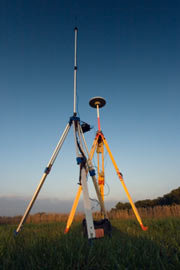
To determine an object’s location, the GPS system must receive a radio signal from at least three satellites. Since each satellite emits a unique signal, the receiver can then match the signal to the satellite and its orbital position. Distance from the receiver is then calculated (for each satellite), and from that data, the receiver accurately calculates its geographic position. But just how accurate is GPS?
What affects GPS accuracy
GPS accuracy is affected by a number of factors, including satellite positions, noise in the radio signal, atmospheric conditions, and natural barriers to the signal. Noise can create an error between 1 to 10 meters and results from static or interference from something near the receiver or something on the same frequency. Objects such a mountains or buildings between the satellite and the receiver can also produce error, sometimes up to 30 meters. The most accurate determination of position occurs when the satellite and receiver have a clear view of each other and no other objects interfere.
Obviously, mountains and clouds can not be controlled or moved, nor can interference and blockage from buildings always be prevented. These factors then, will affect GPS accuracy. To overcome or get around these factors, other technology, AGPS, DGPS, and WAAS, has been developed to aid in determining an accurate location.
Assisted GPS (AGPS/A-GPS)
AGPS (Assisted Global Positioning System) is a system that assists conventional GPS when reception of the radio signal from the satellite is poor or non-existent (line of sight is blocked). To aid in GPS accuracy, the A-GPS gains information via a wireless network, such as the GPS receivers on cell towers, to relay the satellite information to the receiver. With this assistance, the GPS doesn’t have to calculate the satellite’s orbit, which shortens initialization time, and increases battery life.
Differential GPS
To further increase accuracy, DGPS (Differential Global Positioning System) technology was developed. Like the AGPS, the DGPS uses a fixed GPS location (such as a cell tower) to send information to the GPS receiver. DGPS, however, looks at both the satellite and the fixed location adjusts for any difference between the two, and then sends that information to the receiver. DGPS is particularly helpful when atmospheric conditions interfere with reception.
The most recent innovation in GPS technology is the WAAS (Wide Area Augmentation System) developed by the FAA and DOD to augment GPS for air navigation. Utilizing a network of ground-based stations (WRS or Wide-area Reference Stations) which are protected from the public, WAAS transmits corrections to geosynchronous communications satellites, which then transmit the corrections to the user. WAAS was designed to allow aircraft to rely on GPS for all phases of flights, including precision, or “instrument only” landings. Specifications for WAAS require accuracy of 7 meters or better both vertically and laterally, 95% of the time. In practice, WAAS achieved a lateral accuracy of 1 meter and of 1.5 meters vertically when over the contiguous United States. Read more on how WAAS works at WAAS Explained.
Many GPS manufacturers market their products as the more accurate, or having greater sensitivity than their competitors, but the bottom line is that GPS accuracy depends on the GPS technology in use.